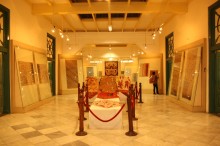25 May 2015
Museum Tekstil Jakarta, Indonesia

 The Museum Tekstil Jakarta (Jakarta Textile Museum) was founded in 1976 as the result of a concerted effort spearheaded by Ali Sadikin, the Governor of Jakarta at the time. It was established in honour of Mme. Tien Soeharto, Indonesia's First Lady, who officiated at the opening on 28 June 1976.
Textiles have always been an important part of life in Indonesia, whether as components of dress or as ritual and ceremonial objects. Traditional textiles constitute a rich aspect of Indonesian culture and a testament to the degree of technological expertise and artistic skill attained by their makers. They also provide a window into local history.
By the mid-1970s, the use of traditional textiles, the understanding of their use and the quantity and quality of production were very evidently in decline. Some had even become extremely rare. This motivated a group of Jakarta's leading citizens to establish an organisation dedicated to the preservation and study of Indonesian textiles. The Himpunan Wastraprema (Society of Textile Lovers) donated 500 high-quality textiles, gleaned from the collections of its members. The city of Jakarta responded by providing accommodation in a lovely old building in the Tanah Abang district.
The Museum continues to grow and develop to respond to the needs of its visitors. Periodically throughout the year, it cooperates with private collectors and various institutions in holding short thematic shows in between its regular displays, such as the ASEAN Textiles Exhibition and a Festival of Indonesian Textiles in general, each accompanied by a seminar and a cultural performance related to the theme of the show. It also hosts special exhibitions and conferences on various aspects of traditional Indonesian textiles.
Permanent collections: One of the most comprehensive collections in the world of a broad range of Indonesian textiles including warp and weft ikat cloths, batik, embroideries, beadwork and multifarious appliqué techniques, tapestry weaves, supplementary warp and weft textiles and from all over the Indonesian Archipelago.
The Museum Tekstil Jakarta (Jakarta Textile Museum) was founded in 1976 as the result of a concerted effort spearheaded by Ali Sadikin, the Governor of Jakarta at the time. It was established in honour of Mme. Tien Soeharto, Indonesia's First Lady, who officiated at the opening on 28 June 1976.
Textiles have always been an important part of life in Indonesia, whether as components of dress or as ritual and ceremonial objects. Traditional textiles constitute a rich aspect of Indonesian culture and a testament to the degree of technological expertise and artistic skill attained by their makers. They also provide a window into local history.
By the mid-1970s, the use of traditional textiles, the understanding of their use and the quantity and quality of production were very evidently in decline. Some had even become extremely rare. This motivated a group of Jakarta's leading citizens to establish an organisation dedicated to the preservation and study of Indonesian textiles. The Himpunan Wastraprema (Society of Textile Lovers) donated 500 high-quality textiles, gleaned from the collections of its members. The city of Jakarta responded by providing accommodation in a lovely old building in the Tanah Abang district.
The Museum continues to grow and develop to respond to the needs of its visitors. Periodically throughout the year, it cooperates with private collectors and various institutions in holding short thematic shows in between its regular displays, such as the ASEAN Textiles Exhibition and a Festival of Indonesian Textiles in general, each accompanied by a seminar and a cultural performance related to the theme of the show. It also hosts special exhibitions and conferences on various aspects of traditional Indonesian textiles.
Permanent collections: One of the most comprehensive collections in the world of a broad range of Indonesian textiles including warp and weft ikat cloths, batik, embroideries, beadwork and multifarious appliqué techniques, tapestry weaves, supplementary warp and weft textiles and from all over the Indonesian Archipelago.
View all Asia-Europe Museum Network (ASEMUS) members in Indonesia
Similar content
posted on
25 Jun 2015
posted on
01 Jul 2015
posted on
23 May 2015
posted on
18 May 2015
posted on
09 Nov 2015
posted on
05 Nov 2015


